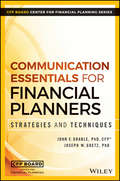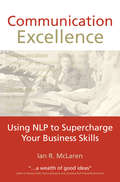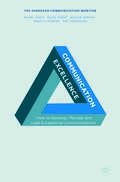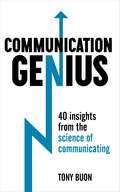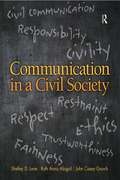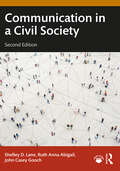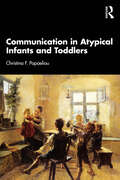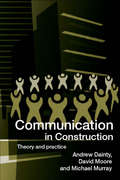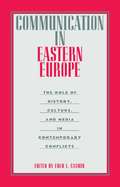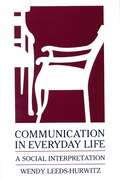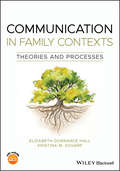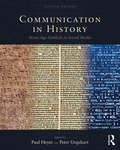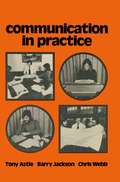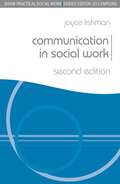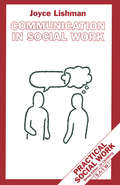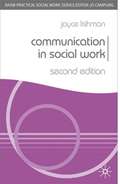- Table View
- List View
Communication Essentials for Financial Planners: Strategies and Techniques
by John E. Grable Joseph W. GoetzExploring the Human Element of Financial Planning Communication Essentials for Financial Planners tackles the counseling side of practice to help financial planners build more productive client relationships. CFP Board’s third book and first in the Financial Planning Series, Communication Essentials will help you learn how to relate to clients on a more fundamental level, and go beyond "hearing" their words to really listen and ultimately respond to what they're saying. Expert coverage of body language, active listening, linguistic signals, and more, all based upon academic theory. There is also an accompanied set of videos that showcase both good and bad communication and counseling within a financial planning context. By merging written and experiential learning supplemented by practice assignments, this book provides an ideal resource for any client-facing financial professional as well as any student on their pathway to CFP® certification. Counseling is a central part of a financial planner's practice, and attention to interpersonal communication goes a long way toward progressing in the field; this guide provides practical instruction on the proven techniques that make a good financial planner great. Build client relationships based on honesty and trust Learn to read body language and the words not spoken Master the art of active listening to help your clients feel heard Tailor your communications to suit the individual client's needs The modern financial planning practice is more than just mathematics and statistical analysis—at its heart, it is based on trust, communication, and commitment. While interpersonal skills have always been a critical ingredient for success, only recently has this aspect been given the weight it deserves with its incorporation into the certification process. Communication Essentials for Financial Planners provides gold-standard guidance for certification and beyond.
Communication Excellence: Using NLP to supercharge your business skills
by Ian R. McLarenThis ten-lesson course will transform you into an excellent communicator. Providing invaluable training in key NLP-based methods, it will increase your ability to: manage; market; sell; influence; inspire; innovate. " ... a wealth of good ideas ..." Judith E. Pearson PhD, Psychotherapist and Certifi ed NLP Trainer/Practitioner
Communication Excellence: How to Develop, Manage and Lead Exceptional Communications
by Ralph Tench Dejan Verčič Ansgar Zerfass Ángeles Moreno Piet VerhoevenExploring the implications of 10 years of data from more than 21,000 communication professionals across Europe, combined with case studies and interviews with senior communication directors from top European companies and organisations, this book provides an insight into how to build, develop and lead excellent communication. It presents a culmination of research and best practice models, covering strategic communication, the impact on reputation, crisis, mediatisation, organisational culture, new digital, social and mobile media as well as the development of professionalisation. Providing clear guidance on the difference between normal and excellent communications departments, the book shows readers how communication can effectively influence and support the organisation and positively fit within the business strategy of today’s global and changing markets. The study behind this book, the European Communication Monitor, is known as the most comprehensive provider of reliable data in the communication field worldwide.
Communication Excellence: How to Develop, Manage and Lead Exceptional Communications
by Ralph Tench Dejan Verčič Ansgar Zerfass Ángeles Moreno Piet VerhoevenExploring the implications of 10 years of data from more than 21,000 communication professionals across Europe, combined with case studies and interviews with senior communication directors from top European companies and organisations, this book provides an insight into how to build, develop and lead excellent communication. It presents a culmination of research and best practice models, covering strategic communication, the impact on reputation, crisis, mediatisation, organisational culture, new digital, social and mobile media as well as the development of professionalisation. Providing clear guidance on the difference between normal and excellent communications departments, the book shows readers how communication can effectively influence and support the organisation and positively fit within the business strategy of today’s global and changing markets. The study behind this book, the European Communication Monitor, is known as the most comprehensive provider of reliable data in the communication field worldwide.
Communication Genius: 40 Insights From the Science of Communicating
by Tony BuonThe fast-track MBA in communicationImagine having instant access to the world's smartest thinking on human communication - and being shown exactly what to do to guarantee that all of your communication is right, every time. Communication Genius makes it easy to apply the scientific facts that researchers know about communication to the real world. 40 chapters based on cutting-edge business and psychology research projects reveal what works and what doesn't work when we interact with each other. Each of the 40 chapters is a mini-masterclass in communicating better, explaining the research and showing you how to apply it for yourself to improve your own communication skills.Too often, conventional wisdom says one thing while research says another. Communication Genius cuts through the noise to bring you proven research and techniques for applying it that will simply make you a better all-round communicator.With chapters on body language, emotional intelligence, neuro-linguistic programming (NLP), presentations, mimicry, groupthink and the latest neuroscience, Communication Genius explodes some myths and gives you the best that science has to offer on communication. Quick to read and intensely practical, this book will bring a little communication genius into your day.'A must read if you want to communicate better' Professor Sir Cary Cooper, Manchester Business School, University of Manchester'Required reading for anyone seeking to better their communication skills in the workplace and otherwise' Dr Anastasia P. Rush, Clinical Psychologist, CEO HELLAS EAP (Greece)'Calls into question accepted 'beliefs' (Maslow's hierarchy) and introduces the reader to an array of new theories from "IQ" racism to the Obama effect' Kate Nowlan, Chief Executive, CiC Employee Assistance, Fellow Royal Society of Arts (FRSA)'Tony has done a fantastic job in pulling together an amazing number of articles and scientific studies and making them understandable to the lay person' Andrew Kinder, Chartered Counselling & Chartered Occupational Psychologist, Employee Assistance Professionals Association (EAPA -UK) Chair
Communication in a Civil Society
by John Gooch Ruth Anne Abigail Shelley D. LaneFirst Published in 2016. Routledge is an imprint of Taylor & Francis, an Informa company.
Communication in a Civil Society
by John Gooch Ruth Anne Abigail Shelley D. LaneFirst Published in 2016. Routledge is an imprint of Taylor & Francis, an Informa company.
Communication in a Civil Society
by Shelley D. Lane Ruth Anna Abigail John Casey GoochUsing the concept of “civility” as the major theme, this fully updated second edition offers a unique and alternative way to teach and learn about communication.The book brings together discrete areas that explore the fundamentals of communication and intrapersonal communication, interpersonal communication, small group communication, and public speaking. Every chapter includes theories, concepts, and examples that allow students to use civil and ethical communication skills in their personal relationships, in collaboration with colleagues, and in giving public speeches and professional presentations. This new edition highlights advances in and concepts related to mediated and technology-based communication, such as chatbots, technostress, and dating apps, and shows how students can engage in civil face-to-face and mediated interaction. Additionally, each chapter includes a real-world incident that students are asked to analyze in terms of specific chapter information and skills related to civility.Communication in a Civil Society is an ideal textbook for Introduction to Communication, Interpersonal Communication, and Public Speaking courses.Materials for instructors including PowerPoint slides, a test bank, and an instructor’s manual, are available at www.routledge.com/9781032513263.
Communication in a Civil Society
by Shelley D. Lane Ruth Anna Abigail John Casey GoochUsing the concept of “civility” as the major theme, this fully updated second edition offers a unique and alternative way to teach and learn about communication.The book brings together discrete areas that explore the fundamentals of communication and intrapersonal communication, interpersonal communication, small group communication, and public speaking. Every chapter includes theories, concepts, and examples that allow students to use civil and ethical communication skills in their personal relationships, in collaboration with colleagues, and in giving public speeches and professional presentations. This new edition highlights advances in and concepts related to mediated and technology-based communication, such as chatbots, technostress, and dating apps, and shows how students can engage in civil face-to-face and mediated interaction. Additionally, each chapter includes a real-world incident that students are asked to analyze in terms of specific chapter information and skills related to civility.Communication in a Civil Society is an ideal textbook for Introduction to Communication, Interpersonal Communication, and Public Speaking courses.Materials for instructors including PowerPoint slides, a test bank, and an instructor’s manual, are available at www.routledge.com/9781032513263.
Communication in Atypical Infants and Toddlers
by Christina F. PapaeliouThis book presents a comparative review of the latest studies and data on prelinguistic communication and early semantic development in autism spectrum disorder (ASD), Williams syndrome (WMS), attention-deficit/hyperactivity disorder (ADHD), and early language delay. Papaeliou offers a critical analysis of the literature, compares key theoretical approaches, and interprets data on development in atypical populations.A fruitful synthesis of theory and research reveals that, instead of cognitive deficits, the core feature of these neurodevelopmental disorders consists of deficits in the ability for self- and intersubjective coordination, which adversely affects early interactions and, consequently, the emergence of language. The book composes fragmentary proposals on the role of rhythm disruptions in different conditions, setting out the idea that disruption in interactional synchrony is a connecting thread through neurodevelopmental disorders which show high prevalence or high comorbidity rates. Papaeliou identifies distinct communicative patterns characteristic of each disorder and puts forward a unifying theory for interpreting data on early communication and language development in atypical populations.This is ideal reading for psychologists, psycholinguists, psychiatrists, paediatricians, speech therapists, and special educators. Students in developmental psychology and anyone interested in understanding the research behind typical and atypical development will also benefit from this text.
Communication in Atypical Infants and Toddlers
by Christina F. PapaeliouThis book presents a comparative review of the latest studies and data on prelinguistic communication and early semantic development in autism spectrum disorder (ASD), Williams syndrome (WMS), attention-deficit/hyperactivity disorder (ADHD), and early language delay. Papaeliou offers a critical analysis of the literature, compares key theoretical approaches, and interprets data on development in atypical populations.A fruitful synthesis of theory and research reveals that, instead of cognitive deficits, the core feature of these neurodevelopmental disorders consists of deficits in the ability for self- and intersubjective coordination, which adversely affects early interactions and, consequently, the emergence of language. The book composes fragmentary proposals on the role of rhythm disruptions in different conditions, setting out the idea that disruption in interactional synchrony is a connecting thread through neurodevelopmental disorders which show high prevalence or high comorbidity rates. Papaeliou identifies distinct communicative patterns characteristic of each disorder and puts forward a unifying theory for interpreting data on early communication and language development in atypical populations.This is ideal reading for psychologists, psycholinguists, psychiatrists, paediatricians, speech therapists, and special educators. Students in developmental psychology and anyone interested in understanding the research behind typical and atypical development will also benefit from this text.
Communication in Construction: Theory and Practice
by Andrew Dainty David Moore Michael MurrayCommunication within project-based environments presents special challenges. This is especially true within the construction industry, where interaction tends to be characterised by unfamiliar groups of people coming together for short periods before disbanding to work on other endeavours. This book examines communication at a number of levels ranging from interpersonal interactions between project participants to corporate communication between organizations. Several non-typical perspectives on the process of communication are introduced to encourage the reader to think about communication in a more innovative manner. The combination of differing perspectives illustrates the diversity of communication problems facing those working within project-based environments. Practical guidance is provided on possible solutions to communication problems, and a number of examples and case studies are presented.
Communication in Construction: Theory and Practice
by Andrew Dainty David Moore Michael MurrayCommunication within project-based environments presents special challenges. This is especially true within the construction industry, where interaction tends to be characterised by unfamiliar groups of people coming together for short periods before disbanding to work on other endeavours. This book examines communication at a number of levels ranging from interpersonal interactions between project participants to corporate communication between organizations. Several non-typical perspectives on the process of communication are introduced to encourage the reader to think about communication in a more innovative manner. The combination of differing perspectives illustrates the diversity of communication problems facing those working within project-based environments. Practical guidance is provided on possible solutions to communication problems, and a number of examples and case studies are presented.
Communication in Eastern Europe: The Role of History, Culture, and Media in Contemporary Conflicts (Routledge Communication Series)
by Fred L. CasmirThis volume represents a clear attempt to learn something from the events in Eastern European countries. It does not start with simplistic or old assumptions based on convenient Western communication models, but instead takes a new approach. If chaos theory could fundamentally change how physicists looked at order in the universe, then it may be of value for communication scholars to attempt to understand the diversity of chaos or order in the human universe, rather than attempt to force existing models on it for their own explanatory purposes. This book is not merely based on the study of select groups of university students or on laboratory settings created in the minds of social scientists. It seeks to understand some of the "real world," including the historical backgrounds and the theoretical assumptions brought to studies of intercultural conflicts. Using personal and professional insights developed during firsthand contacts with existing situations, chapter authors illustrate some of the realities by using the complexity of changes in Eastern European states during the final decade of the 20th century. From education to business, from the role of women to the role of mass media, from the impact of political systems to the impact of history, communication between those who are culturally diverse, though they may have been arbitrarily forced to live under the same "political roof," is the theme of these scholarly studies. The editor's reason for developing this volume of original essays is his belief that diversity rather than assumed similarity or even sameness -- based on the use of inadequate terminology -- is necessary for learning from contemporary human experiences. He further believes that diversity and the significant roles of cultural values as well as of history need to become key concepts in the model with which to begin when it comes to the study of various aspects of intercultural communication. It is therefore vital that scholars who represent various points of view and backgrounds contribute to that process. After all, understanding what is happening in the world is centrally anchored in or related to effective and successful "intercultural" communication between scholars who have different academic and personal backgrounds.
Communication in Eastern Europe: The Role of History, Culture, and Media in Contemporary Conflicts (Routledge Communication Series)
by Fred L. CasmirThis volume represents a clear attempt to learn something from the events in Eastern European countries. It does not start with simplistic or old assumptions based on convenient Western communication models, but instead takes a new approach. If chaos theory could fundamentally change how physicists looked at order in the universe, then it may be of value for communication scholars to attempt to understand the diversity of chaos or order in the human universe, rather than attempt to force existing models on it for their own explanatory purposes. This book is not merely based on the study of select groups of university students or on laboratory settings created in the minds of social scientists. It seeks to understand some of the "real world," including the historical backgrounds and the theoretical assumptions brought to studies of intercultural conflicts. Using personal and professional insights developed during firsthand contacts with existing situations, chapter authors illustrate some of the realities by using the complexity of changes in Eastern European states during the final decade of the 20th century. From education to business, from the role of women to the role of mass media, from the impact of political systems to the impact of history, communication between those who are culturally diverse, though they may have been arbitrarily forced to live under the same "political roof," is the theme of these scholarly studies. The editor's reason for developing this volume of original essays is his belief that diversity rather than assumed similarity or even sameness -- based on the use of inadequate terminology -- is necessary for learning from contemporary human experiences. He further believes that diversity and the significant roles of cultural values as well as of history need to become key concepts in the model with which to begin when it comes to the study of various aspects of intercultural communication. It is therefore vital that scholars who represent various points of view and backgrounds contribute to that process. After all, understanding what is happening in the world is centrally anchored in or related to effective and successful "intercultural" communication between scholars who have different academic and personal backgrounds.
Communication in Everyday Life: A Social Interpretation
by Wendy Leeds-Hurwitz(This book) is a clearly written and well-documented review of social communication theory, and an alternative to texts which focus primarily on the psychology of interpersonal communication and tend to exclude the social perspective on understanding interpersonal communication. Leeds-Hurwitz provides a welcome addition to introductory texts on the study of human communication. (This) is for teachers who have searched for an introductory textbook which presents a comprehensive argument for a social interactionist perspective on communication in a way understandable to students. Most refreshing is that Leeds-Hurwitz does not talk down to the reader, integrates (not just cites) original sources, and illustrates the concepts with ethnographic research…. Mark Kuhn, University of Maine, Orono in Communication Education
Communication in Family Contexts: Theories and Processes
by Elizabeth Dorrance Hall Kristina M. ScharpAn innovative, student-friendly textbook covering the major elements of the field of Family Communication Family Communication, a rapidly growing sub-discipline within Communication Studies, explores the processes and factors involved in family interactions and relationships. Communication in Family Contexts is a clear and accessible survey of the essential principles, theories, and concepts of the field. Unlike textbooks that present a vast amount of material across only a few chapters—this innovative textbook features brief, easily-understood chapters ideally-suited for undergraduate courses on the subject. The text provides concise yet comprehensive coverage of a diverse range of topics, from fundamental aspects of caretaking and sibling communication, to topics not covered in other textbooks such as estrangement and marginalization. 33 chapters cover theories of family communication, family communication processes, and communicating in family relationships. The authors, noted researchers and educators in the field, complement discussions of standard topics with those of growing contemporary interest, such as LGBTQ family communication, step-family and half-sibling relationships, and the influence of technology on family. This textbook: Provides a well-rounded examination of the major elements of Family Communication studies Explains the foundational theories of the field, including Family Communication Patterns Theory and Relational Dialectics Theory Features numerous practical application exercises to enable students apply theory to practice Includes a complete set pedagogical features, such as case studies, visualizations and models of theories, illustrations, and discussion questions Offers a flexible organizational structure that allows instructors to pick and choose chapters to meet the needs of their courses Communication in Family Contexts: Theories and Processes is an important resource for instructors and students in the field of family communication, the wider discipline of Communication Studies, and related areas such as social psychology and sociology.
Communication in Family Contexts: Theories and Processes
by Elizabeth Dorrance Hall Kristina M. ScharpAn innovative, student-friendly textbook covering the major elements of the field of Family Communication Family Communication, a rapidly growing sub-discipline within Communication Studies, explores the processes and factors involved in family interactions and relationships. Communication in Family Contexts is a clear and accessible survey of the essential principles, theories, and concepts of the field. Unlike textbooks that present a vast amount of material across only a few chapters—this innovative textbook features brief, easily-understood chapters ideally-suited for undergraduate courses on the subject. The text provides concise yet comprehensive coverage of a diverse range of topics, from fundamental aspects of caretaking and sibling communication, to topics not covered in other textbooks such as estrangement and marginalization. 33 chapters cover theories of family communication, family communication processes, and communicating in family relationships. The authors, noted researchers and educators in the field, complement discussions of standard topics with those of growing contemporary interest, such as LGBTQ family communication, step-family and half-sibling relationships, and the influence of technology on family. This textbook: Provides a well-rounded examination of the major elements of Family Communication studies Explains the foundational theories of the field, including Family Communication Patterns Theory and Relational Dialectics Theory Features numerous practical application exercises to enable students apply theory to practice Includes a complete set pedagogical features, such as case studies, visualizations and models of theories, illustrations, and discussion questions Offers a flexible organizational structure that allows instructors to pick and choose chapters to meet the needs of their courses Communication in Family Contexts: Theories and Processes is an important resource for instructors and students in the field of family communication, the wider discipline of Communication Studies, and related areas such as social psychology and sociology.
Communication in History: Stone-Age Symbols to Social Media
by David Crowley Peter Urquhart Paul HeyerNow in its 7th edition, Communication in History reveals how media has been influential in both maintaining social order and as powerful agents of change. Thirty-eight contributions from a wide range of voices offer instructors the opportunity to customize their courses while challenging students to build upon their own knowledge and skill sets. From stone-age symbols and early writing to the Internet and social media, readers are introduced to an expansive, intellectually enlivening study of the relationship between human history and communication media.
Communication in History: Stone Age Symbols to Social Media
by Peter Urquhart Paul HeyerNow in its 7th edition, Communication in History reveals how media has been influential in both maintaining social order and as powerful agents of change. Thirty-eight contributions from a wide range of voices offer instructors the opportunity to customize their courses while challenging students to build upon their own knowledge and skill sets. From stone-age symbols and early writing to the Internet and social media, readers are introduced to an expansive, intellectually enlivening study of the relationship between human history and communication media.
Communication in Organizational Environments: Functions, Determinants and Areas of Influence
by Anna Rogala Sylwester BialowasThis book showcases an interdisciplinary and comprehensive study of the issues related to communication in corporate environments. Including perspectives from psychology, sociology and management science, Communication in Organizational Environments analyzes original quantitative and qualitative research, and determines the functions, objectives and conditions of effective internal communication. In this book, the authors bridge the gap in the literature on the management of corporate internal communication, and provide a tool for measuring communication effectiveness. Useful as a guide for internal communication managers in various organizations, this book is also important reading for academics in corporate communication, public relations, corporate management and behaviour, and human resource management.
Communication in Social Work (Practical Social Work Series)
by Joyce LishmanEffective communication is a vital part of the social worker's job. This welcome new edition of a classic text provides students and practitioners with essential advice and guidance about communicating and interacting in a range of social work settings. Based on the author's extensive personal and teaching experience, the text offers a succint introduction to a variety of communication techniques, including symbolic, non-verbal, verbal, written and electronic forms of communication. Importantly, it discusses the perspectives of service users and explores their experiences and interpretations of how a social worker looks, acts and speaks, thus giving a real insight into the implicit messages being conveyed. New to this edition are Putting it into Practice activities and further reading suggestions, designed to support learning and understanding and to enable readers to reflect critically for practice. Written in an appealing narrative style that cannot fail to draw the reader in, Communication in Social Work is an engaging and comprehensive book suitable both for social work and social care students and for newly qualified practitioners wanting to refresh their thinking and skills.
Communication in Social Work (Practical Social Work Series)
by Joyce LishmanUsing knowledge of communication skills from different sources (studies of chat perception, social psychology, evaluation research and practice theory), this volume introduces and examines the non-verbal, symbolic, verbal and written communication skills required for social work practice in all settings. It then applies this basic knowledge and understanding to different purposes of social work; relationship building and maintaining, listening, giving information and advice, making a contract and intervention to help clients problem-solve or change attitudes or behaviour.
Communication In Social Work (PDF)
by Joyce Lishman Jo CamplingThis timely new edition identifies the important skills integral to effective communication in social work. Based on the premise that good communication skills are essential to good social work, the second edition offers an extended account of its subject that pays more attention to the diverse contexts of social work and the range of clients and users with whom practitioners come in contact.
